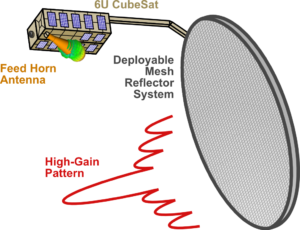
High-gain antenna concept for small CubeSats. This artistic rendition illustrates the challenge to obtain high-gain antenna performance for compact volumes.
Space exploration has long been limited to the rich and famous, i.e. big organizations with substantial government funding. Possibly the biggest impediment for small organizations (e.g. research labs, start-ups) is the cost to send objects into space. Materials and fuel are expensive, not to mention the serious engineering it takes to design the rockets and spacecraft. A recent movement within the satellite community has made significant strides towards making space more accessible to the little guy by developing the CubeSat concept. The basic idea is to make a very small satellite–anywhere from the size of your phone to the size of a moving box–which packages all important components necessary for operation. This was made possible by the shrinking size of electronics and the development of tiny MEMS sensor and actuator technologies. The small CubeSat size allows them to be launched as secondary payloads, which significantly lowers cost for deployment. With a CubeSat satellite design standard now in place, creating commercial-off-the-shelf components for CubeSats becomes a viable marketplace for new companies. Using off-the-shelf components also lowers the costs for CubeSat developers. With such appealing features, CubeSats have now attracted many industry and research ventures, but many big challenges still lie ahead for CubeSats.
My recent research has focused on developing high-gain antenna designs for CubeSats. In general, high-gain antennas come with a large physical aperture size, which might seem counterproductive with the CubeSat vision. Attempting to stow a large antenna within the small CubeSat volume makes this a demanding design problem. Despite this difficulty, high-gain antennas would be extremely advantageous for CubeSats for remote sensing and communications applications. High-gain can provide both stronger signals and smaller beamwidths, enabling fine resolution measurements in space. Illustrated in the figure to the right is one possibility for a high-gain antenna: a deployable offset parabolic reflector system. I am currently collaborating with JPL, Prof. Rahmat-Samii, and other UCLA students to build a large deployable reflector antenna (with a size near 1 meter). We are also working with several industrial partners to develop the mechanical deployment operation that would enable compact stowage while still maintaining good RF performance.
Related Publications
- Synthesis and Analysis of Low Profile, Metal-Only Stepped Parabolic Reflector Antenna
V. Manohar, J. M. Kovitz and Y. Rahmat-Samii, “Synthesis and Analysis of Low Profile, Metal-Only Stepped Parabolic Reflector Antenna,” in IEEE Transactions on Antennas and Propagation, vol. 66, no. 6, pp. 2788-2798, June 2018.
- A Novel Near-field Gregorian Reflectarray Antenna Design with a Compact Deployment Strategy for High performance Cubesats
Y. Rahmat-Samii, J. M. Kovitz, J. F. Budhu, and V. Manohar, “A Novel Near-field Gregorian Reflectarray Antenna Design with a Compact Deployment Strategy for High performance Cubesats,” 39th Annual Meeting of Antenna Measurement Techniques Assoc., October 2017.
- Feed Horn Optimization using Feed+Reflector Co-Simulation for Advanced Reflector Antennas
J. M. Kovitz, V. Manohar, and Y. Rahmat-Samii, “Feed Horn Optimization using Feed+Reflector Co-Simulation for Advanced Reflector Antennas,” 2017 International Applied Computational Electromagnetics Society (ACES) Symposium, March 2017.
- Think Small, Dream Big: Reviewing Recent Antenna Developments for CubeSats
Y. Rahmat-Samii, V. Manohar, and J. M. Kovitz, “For Satellites, Think Small, Dream Big: Reviewing Recent Antenna Developments for CubeSats,” IEEE Antennas and Propagation Magazine, vol. 59, no. 2, pp. 22 – 30, April 2017.
- A Novel Customized Spline-Profiled mm-Wave Horn Antenna for Emerging High Performance CubeSats
V. Manohar, J. M. Kovitz and Y. Rahmat-Samii, “A Novel Customized Spline-Profiled mm-Wave Horn Antenna for Emerging High Performance CubeSats,” 38th Annual Meeting of Antenna Measurement Techniques Assoc., October 2016.
- Ka band Umbrella Reflectors for CubeSats: Revisiting Optimal Feed Location and Gain Loss
V. Manohar, J. M. Kovitz and Y. Rahmat-Samii, “Ka band Umbrella Reflectors for CubeSats: Revisiting Optimal Feed Location and Gain Loss,” International Conference on Electromagnetics in Advanced Applications, September 2016.
- A Spline-Profiled Conical Horn Antenna Assembly Optimized for Deployable Ka-Band Offset Reflector Antennas in CubeSats
J. M. Kovitz, V. Manohar, and Y. Rahmat-Samii. “A Spline-Profiled Conical Horn Antenna Assembly Optimized for Deployable Ka-Band Offset Reflector Antennas in CubeSats,” in Proceedings of the IEEE Antennas and Propagation International Symposium, Fajardo, Puerto Rico, June 2016.
